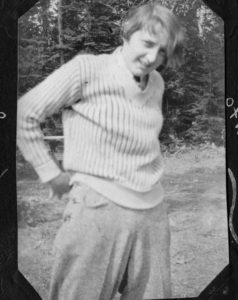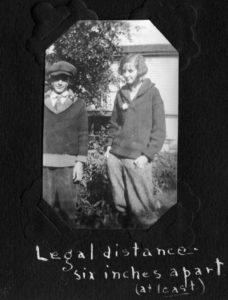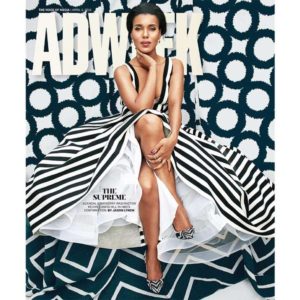
My mother, Helen Marjorie Pascoe (before her last name was Valentine), on a camping trip, wearing pants. From a 1924 photo album
What women wear
What do women wear? And why? As a long-time woman scientist—and a former tomboy—I’ve always been inclined to wear slacks—pants—to work and around the house. This modified form of menswear–tailored to fit the female form–is practical, comfortable, neat, and easy to care for. Also, if you’re working with men, it is far less likely to arouse the male libido—always on hair-trigger alert—than is more “feminine” (i.e., seductive) attire.
However, when I started my first “real job” as a research scientist (not a technician, nor a graduate student, nor a post-doctoral fellow) at the medical university in Charleston, South Carolina in 1970, I could not wear jeans or slacks to work because there was an institution-wide clothing rule that said women must wear dresses or skirts to work.
Historical Perspective
Just to put this in historical perspective, the women’s movement was already more than a century old by that time. Moreover, women had already begun to wear bloomers and pantaloons. These had become fashionable with progressive women in the mid-to-late 1800s, It was much easier to ride a horse—and to walk and perform most other activities—in bloomers than in skirts. The bloomer—sometimes called Turkish style—was inspired by Middle-Eastern harem dress, and it became something of a vogue among British international sophisticates.
It also figured into the health-promotion movement of the late nineteenth century, partly because women’s dress styles had become physically debilitating, with their unyielding corsets and stays and tight laces. The Victorian travel writer, Isabella Bird Bishop[1] wore pants on many of her peregrinations throughout the world, especially in the western United States, where her major transportation was by horseback.
Many suffragettes wore bloomers and pantaloons at the turn of the twentieth century as they marched and campaigned for the vote in England and America. They were often manhandled and thrown into prison, and pants provided more protection and were less cumbersome than the traditional dresses of the time.

Mom’s sister, my Aunt Jan, is wearing pants. (The caption says, “Legal distance six inches apart (at least),” 1924 photo.)
Finally, when women DID achieve the vote, women’s clothing styles again changed radically. The roaring twenties were a time of flapper dresses for social activities and pants for outdoor recreation. I recently ran across photos of my mother, an early “liberated woman,” (above) wearing pants during a woodland excursion. Indeed, she wore pants for most of her life, unlike the majority of our neighborhood women in small-town Michigan, where she and my father settled and raised their family.
Back to the 1970s
So let’s go back to the 1970s. The fashion industry of the time had interpreted the incipient feminist movement of the 1960s as a sexual liberation movement–the only aspect of it that most men reacted to positively. So styles increasingly sexualized women, revealing more and more of the body until just boobs and butt were covered by mini-skirts and tops. I refused to wear mini-skirts, and our institutional administrators soon realized that fashionable women’s clothing was no longer “lady like.” They belatedly issued a decree that women could wear slacks or jeans to work. I never went back to dresses or skirts.[2]
What’s Happening Today?
However, every time there is an anti-feminist backlash in our culture, the clothing fashions become more revealing and women become increasingly sexualized. And that is happening now. Today.

Magazine cover that was controversial because the model was photoshopped
A magazine cover for Adweek was a recent source of controversy because the model was photoshopped. There was no outcry over the overly exposed model (despite an elaborate dress) or the fact that the center of the image, just barely covered by other flesh—and to which the eye is unconsciously drawn—is the woman’s perineum (otherwise known as c…t).
It’s pathetic that women go along with the narrative that they are primarily sexual beings–and with the consequent exploitation. It takes almost nothing to arouse a man, so why go to these extremes? Do we really want to keep them aroused all the time?[3] Isn’t it time to take a calm-down pill?
Indeed, in the contemporary atmosphere of attention-grabbing and immediate-gratification, it seems that the more outrageous a fad or fashion, the more popular it becomes—temporarily.
And this is the thing. Temporary just doesn’t last.
Footnotes for a blogpost? How bizarre!
[1] Isabella Bird Bishop was a Victorian travel writer and the first Western woman to visit many parts of the world such as Afghanistan and the Korean back country. I quote her extensively in a travel memoir, “Korea, Are You at Peace?”
[2] I realize I’m going to need to do another blog post on shoes. And maybe another about non-Western women and what they’re expected to wear.
[3] I once had an argument/discussion with a male colleague who didn’t believe me when I told him that women don’t think about sex all the time. He admitted that men think about sex about 90% of the time. I estimated that women think about it perhaps 10% of the time. This may have been the original reason for segregation of the sexes in civilized societies. There really is a psychological disconnect between men and women.

Maybe it’s a generational thing, but I also don’t think there’s anything feminist about a woman who is barely dressed. A woman can be strong, confident, and love her body without buying into someone else’s idea of what constitutes an attractive woman. I suspect men think about sex so often because it’s a biological, evolutionary instinct, but it does get tiring, as a woman, to be primarily judged first on the way we dress and how pretty we are. I can imagine you’ve struggled more with this as a scientist than I did as an elementary school teacher.
You may be right, but it’s a problem for women in lots of places other than the workplace too. The problem with the workplace is that we spend so much of our time there, AND we’re also stuck with having to deal with those who share that space with us.
This is interesting to revisit in light of the awful Burkini ban stuff going on in France. Clothing, lack of it, style of it or too much of it, seems destined to speak louder than the woman within.
Fran, I SO agree. Why are we still allowing males to dictate what women wear? I’m afraid we’re pretty brainwashed–even “liberated” women. I suspect that instinct has a lot to do with the way women defer to men. It’s not all just cultural conditioning. Maybe the feistier women (females as strong or determined as males) simply didn’t breed as much–didn’t have as many children–as their more compliant sisters. Among mammals in general, males are stronger than females. So they can battle other males for mating privileges and can overcome resistance from unwilling females.